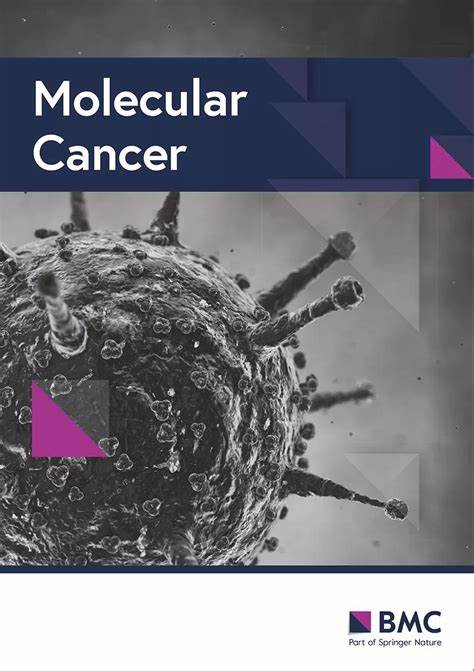EGFR-mediated local invasiveness and response to Cetuximab in head and neck cancer
IF 33.9
1区 医学
Q1 BIOCHEMISTRY & MOLECULAR BIOLOGY
引用次数: 0
Abstract
Recurrent/metastatic head and neck squamous cell carcinoma (R/M-HNSCC) is a severe, frequently lethal condition. Oncogene addiction to epidermal growth factor receptor (EGFR) is a hallmark of HNSCC, but the clinical efficacy of EGFR-targeted therapies remains low. Understanding molecular networks governing EGFR-driven progression is paramount to the exploration of (co)-treatment targets and predictive markers. We performed function-based mapping of differentially expressed genes in EGFR-mediated local invasion (fDEGs) using photoconvertible tracers and RNA-sequencing (RNA-seq) in a cellular 3D-model. Upon alignment with public single-cell RNA-seq (scRNA-seq) datasets and HNSCC-specific regulons, a gene regulatory network of local invasion (invGRN) was inferred from gene expression data, which was overrepresented in budding tumors. InvGRN comprises the central hubs inhibin subunit beta alpha (INHBA) and snail family transcriptional repressor 2 (SNAI2), and druggable fDEGs integrin subunit beta 4 (ITGB4), laminin 5 (LAMB3/LAMC2), and sphingosine kinase 1 (SPHK1). Blockade of INHBA repressed local invasion and was reverted by activin A, laminin 5, and sphingosine-1-phosphate, demonstrating a functional interconnectivity of the invGRN. Epithelial-to-mesenchymal transition (EMT) of malignant cells and the invGRN are induced by newly defined EGFR-activity subtypes with prognostic value that are promoted by amphiregulin (AREG) and epiregulin (EREG). Importantly, co-inhibition of SPHK1 showed synthetic effects on Cetuximab-mediated invasion blockade and high expression of selected fDEGs was associated with response to Cetuximab in patient-derived xenotransplantation (PDX) and R/M-HNSCC patients. We describe an actionable network of EGFR-mediated local invasion and define druggable effectors with predictive potential regarding the response of R/M-HNSCC to Cetuximab.egfr介导的头颈癌局部侵袭性和对西妥昔单抗的反应
复发/转移性头颈部鳞状细胞癌(R/M-HNSCC)是一种严重的、经常致命的疾病。癌基因对表皮生长因子受体(EGFR)的依赖是HNSCC的一个标志,但EGFR靶向治疗的临床疗效仍然很低。了解控制egfr驱动进展的分子网络对于探索(co)治疗靶点和预测标记物至关重要。我们在细胞3d模型中使用光转化示踪剂和rna测序(RNA-seq)对egfr介导的局部入侵(fDEGs)中差异表达基因进行了基于功能的定位。在与公开的单细胞RNA-seq (scRNA-seq)数据集和hnscc特异性调控进行比对后,从基因表达数据推断出了局部入侵的基因调控网络(invGRN),该网络在萌芽肿瘤中被过度代表。InvGRN包括抑制素- α亚基(INHBA)和蜗牛家族转录抑制因子2 (SNAI2),以及可药物fDEGs整合素- 4 (ITGB4),层粘连蛋白5 (LAMB3/LAMC2)和鞘氨酸激酶1 (SPHK1)。INHBA的阻断抑制了局部入侵,并通过激活素A、层粘连蛋白5和鞘氨醇-1-磷酸恢复,证明了INHBA的功能互联性。新定义的具有预后价值的egfr活性亚型可由双调节蛋白(AREG)和表调节蛋白(EREG)促进,从而诱导恶性细胞的上皮-间质转化(EMT)和invGRN。重要的是,SPHK1的共抑制对西妥昔单抗介导的侵袭阻断有综合作用,在患者源性异种移植(PDX)和R/M-HNSCC患者中,高表达的选定fdeg与西妥昔单抗的应答相关。我们描述了一个可操作的egfr介导的局部侵袭网络,并定义了可用于预测R/M-HNSCC对西妥昔单抗反应的药物效应。
本文章由计算机程序翻译,如有差异,请以英文原文为准。
求助全文
约1分钟内获得全文
求助全文
来源期刊

Molecular Cancer
医学-生化与分子生物学
CiteScore
54.90
自引率
2.70%
发文量
224
审稿时长
2 months
期刊介绍:
Molecular Cancer is a platform that encourages the exchange of ideas and discoveries in the field of cancer research, particularly focusing on the molecular aspects. Our goal is to facilitate discussions and provide insights into various areas of cancer and related biomedical science. We welcome articles from basic, translational, and clinical research that contribute to the advancement of understanding, prevention, diagnosis, and treatment of cancer.
The scope of topics covered in Molecular Cancer is diverse and inclusive. These include, but are not limited to, cell and tumor biology, angiogenesis, utilizing animal models, understanding metastasis, exploring cancer antigens and the immune response, investigating cellular signaling and molecular biology, examining epidemiology, genetic and molecular profiling of cancer, identifying molecular targets, studying cancer stem cells, exploring DNA damage and repair mechanisms, analyzing cell cycle regulation, investigating apoptosis, exploring molecular virology, and evaluating vaccine and antibody-based cancer therapies.
Molecular Cancer serves as an important platform for sharing exciting discoveries in cancer-related research. It offers an unparalleled opportunity to communicate information to both specialists and the general public. The online presence of Molecular Cancer enables immediate publication of accepted articles and facilitates the presentation of large datasets and supplementary information. This ensures that new research is efficiently and rapidly disseminated to the scientific community.
 求助内容:
求助内容: 应助结果提醒方式:
应助结果提醒方式:


